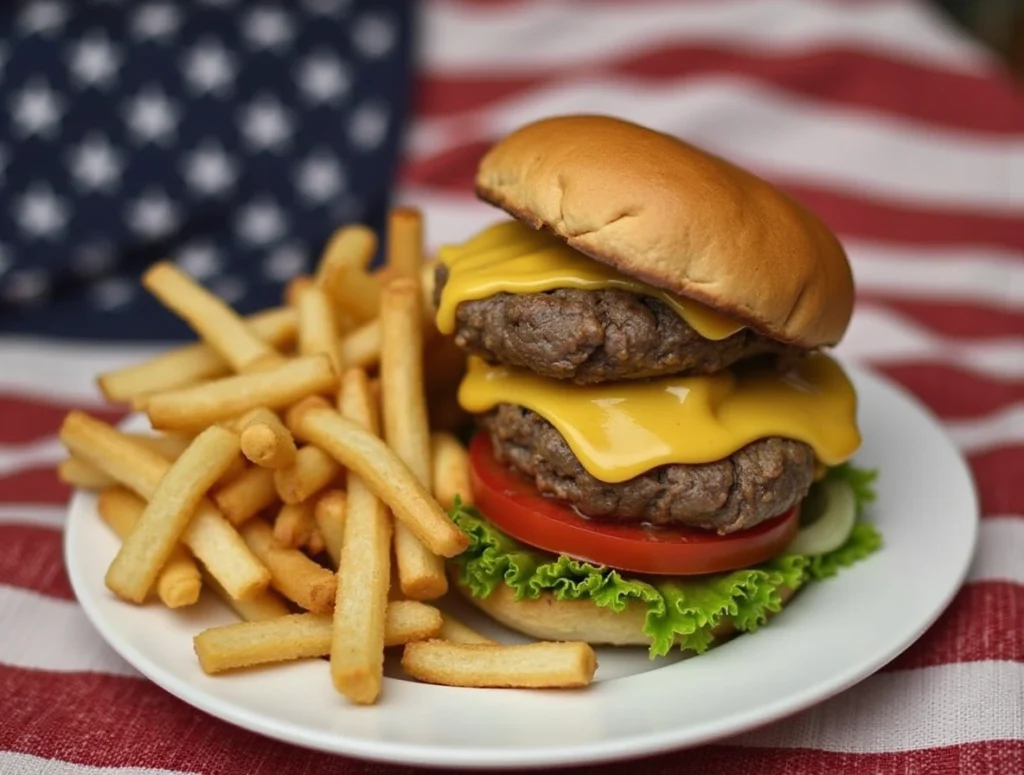
10 Must-Try Classic American Foods & Dishes
Introduction: Top 10 American Foods Culinary Soul on a Plate
Welcome, food lovers! It’s HAMZA here, and today, we’re diving fork-first into the heart and soul of American cuisine. After 28 years in professional kitchens across the country, nothing captures the American spirit quite like its iconic foods. These dishes tell stories of immigration, innovation, regional pride, and the beautiful cultural melting pot that defines this nation’s culinary identity.
From the sizzle of a perfectly grilled burger to the sweet aroma of apple pie cooling on a windowsill, classic American foods combine comfort, boldness, and often a touch of indulgence. Whether you’re a home cook looking to master these staples, a foodie exploring cultural cuisine, or simply craving a taste of nostalgia, this comprehensive guide to the top 10 American foods will satisfy your hunger—both for knowledge and these irresistible dishes.
I’ve spent decades perfecting these recipes, understanding their history, and putting my gourmet spin on them. Today, I’m sharing a list and a celebration of the dishes that have shaped America’s culinary landscape. Let’s explore what makes these foods so special, how they’ve evolved, and most importantly—how to create the ultimate version of each one in your kitchen.
The Evolution of American Foods Cuisine: A Brief History
Before we dive into our top 10 list, let’s take a moment to understand how American cuisine developed into what it is today. Like the country itself, American food’s story is one of fusion, adaptation, and reinvention.
Native Roots and Colonial Influences
The foundation of American cuisine begins with indigenous ingredients—corn, beans, squash, wild game, and berries. Native Americans had sophisticated cooking methods that European settlers gradually adopted and adapted. The Thanksgiving turkey, for example, represents this early cultural exchange.
When European colonists arrived, they brought their culinary traditions but had to adapt them to locally available ingredients. This began the American tradition of culinary improvisation that continues today.
Immigrant Waves and Regional Distinctions
Each wave of immigration—German, Italian, Irish, Chinese, Mexican, and countless others—added new dimensions to American food. These influences didn’t remain separate but merged with existing traditions to create something uniquely American.
Geographic differences led to distinct regional cuisines:
- The seafood-rich coastal areas developed clam chowders and lobster rolls
- The South created soul food and barbecue traditions
- The Midwest became known for hearty, farm-fresh comfort foods
- The Southwest developed its distinctive Tex-Mex flavors
The Modern Era: From Fast Food to Farm-to-Table
The 20th century saw the rise of convenience foods, TV dinners, and the fast-food revolution that brought standardized burgers and fries to every corner of the country. We’ve recently seen a renewed interest in artisanal production, local sourcing, and creative reinterpretations of these classic dishes.
Today’s American cuisine honors these traditional foods while constantly reinventing them—adding global flavors, focusing on sustainability, and celebrating regional distinctions more than ever.
The Ultimate Top 10 American Foods
Now, let’s dive into what you’ve been waiting for—the definitive ranking of America’s most iconic dishes. These selections reflect not just popularity but cultural impact, historical significance, and that indefinable quality that makes them essentially American.
1. The Hamburger: Top 10 american Food Global Food Ambassador
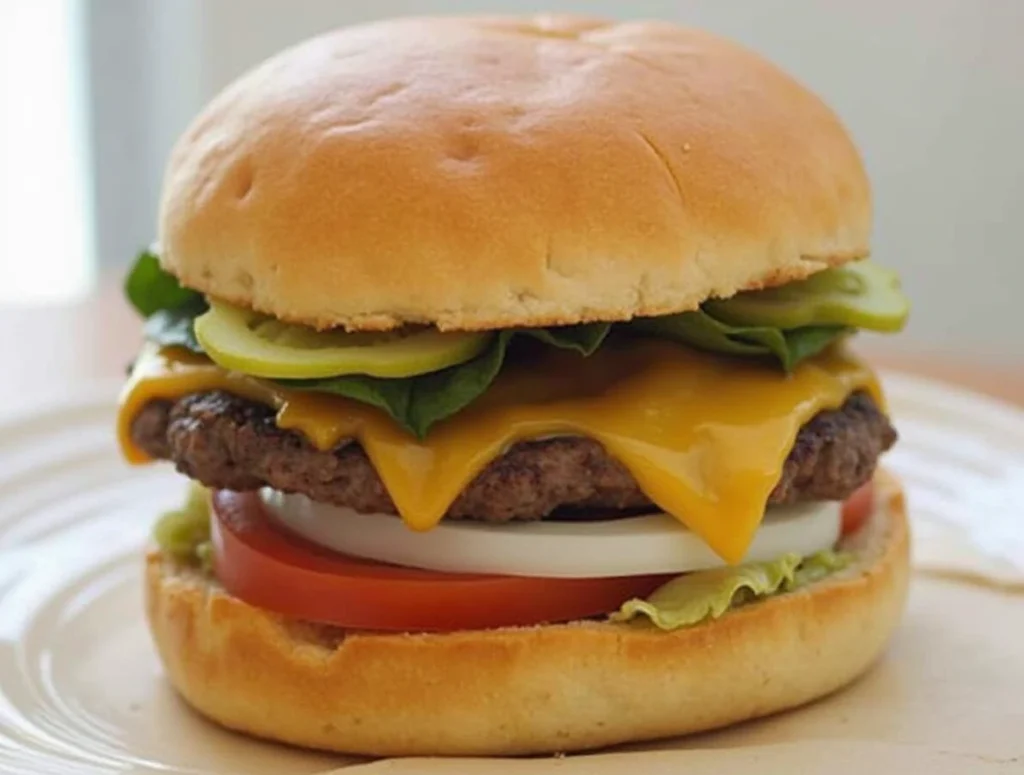
The hamburger is perhaps the most recognizable American food worldwide. What began as a humble sandwich has evolved into a canvas for culinary creativity, spanning fast-food simplicity to gourmet masterpieces.
History of the top 10 American foods Burger
While minced meat has ancient origins, the hamburger as we know it today took shape in America in the late 19th century. Several establishments claim to have invented the modern hamburger, including Louis’ Lunch in New Haven, Connecticut (1900), and the Menches Brothers at an 1885 fair in Hamburg, New York.
The burger became an American institution in the 1950s with the rise of fast-food chains like McDonald’s and Burger King, making this previously regional specialty available from coast to coast.
What Makes the Perfect Burger
After decades of grilling burgers in professional kitchens, I’ve learned that perfection lies in these key elements:
- The Meat: Ideally, 80/20 beef (80% lean, 20% fat) for the perfect balance of flavor and juiciness
- The Cooking Method: High heat to create a flavorful crust while keeping the interior juicy
- The Bun: A slightly sweet, toasted bun that can stand up to the juices without falling apart
- The Toppings: Fresh vegetables, carefully selected cheese, and condiments that complement rather than overpower
Chef HAMZA’s Ultimate Burger Recipe
Here’s my signature recipe that combines classic elements with gourmet touches:
Ingredients
2 pounds freshly ground chuck (80/20)
1 tablespoon Worcestershire sauce
1 teaspoon garlic powder
Salt and freshly ground black pepper
4 brioche buns, split
4 slices aged cheddar cheese
4 leaves butter lettuce
2 ripe tomatoes, sliced
1 red onion, thinly sliced
Special sauce: 1/4 cup mayo, one tablespoon ketchup, one teaspoon pickle relish, a dash of hot sauce
Method:
- Mix beef with Worcestershire, garlic powder, one teaspoon salt, and 1/2 teaspoon pepper. Form into four patties with a slight depression in the center (prevents bulging).
- Let patties rest at room temperature for 30 minutes before cooking.
- Heat a cast-iron skillet or grill to high heat. Cook patties for 3-4 minutes per side for medium.
- Top with cheese during the last minute of cooking.
- Meanwhile, toast the buns lightly.
- Assemble with special sauce on the bottom Bun, then lettuce, burger, tomato, and onion.
A well-crafted burger needs no frills to be extraordinary—just quality ingredients and proper technique.
2. Apple Pie: The Sweet Symbol of America
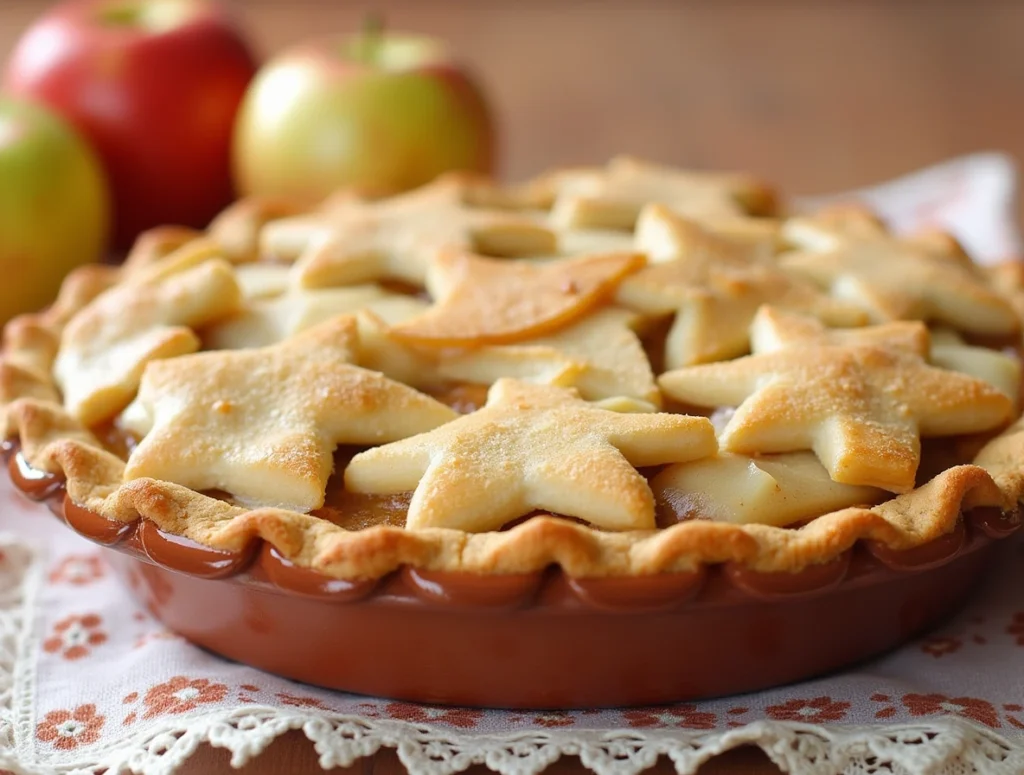
“As American as apple pie,” goes the saying, and even though apple pie existed in Europe long before the colonization of America, this dessert has become synonymous with American identity and comfort.
The American Foods Apple Pie Tradition
Apple pie gained its American identity during the colonial period when European recipes merged with the abundant apple harvests of the New World. By the early 20th century, it had become a symbol of American prosperity and maternal nurturing. It was featured in everything from wartime propaganda (“We’re fighting for Mom and apple pie”) to modern marketing.
What distinguishes American apple pie from its European ancestors is often the generous filling, the flaky double crust, and the balanced spice profile that enhances rather than masks the apple flavor.
Regional Variations Worth Noting
Across America, regional takes on apple pie showcase local preferences:
- New England style features sharp cheddar cheese either baked into the crust or served alongside
- Pennsylvania Dutch apple pie often includes sour cream in the filling
- Southern versions might incorporate bourbon or use lard for an exceptionally flaky crust
- Midwestern apple pies tend to focus on simplicity, letting local apples shine
The Perfect Apple Pie: Secrets From My Kitchen
After years of perfecting this American classic, here are my essential tips:
- Variety Matters: Combine apple varieties for complex flavor—tart Granny Smith, sweet Honeycrisp, and aromatic Braeburn make an excellent trio
- Pre-Cook Your Filling: Briefly cooking the apples before baking prevents the gap between filling and crust
- Cold Butter, Warm Reputation: Keep your pie dough ingredients cold for the flakiest crust
- Egg Wash Artistry: A simple egg wash creates that beautiful golden shine
Chef HAMZA’s Heirloom Apple Pie Recipe
This recipe has won me blue ribbons at three county fairs:
For the crust :
2½ cups all-purpose flour
1 tablespoon sugar
1 teaspoon salt
1 cup cold unsalted butter, cubed
¼ to ½ cup ice water
1 tablespoon apple cider vinegar
- For the filling :
3 pounds mixed apples (Granny Smith, Honeycrisp, Braeburn), peeled and sliced
¾ cup sugar (adjust based on apple sweetness)
2 tablespoons fresh lemon juice
2 tablespoons cornstarch
1 teaspoon cinnamon
¼ teaspoon nutmeg
¼ teaspoon allspice
Pinch of salt
2 tablespoons unsalted butter, cut into small pieces
1 egg beaten with 1 tablespoon water for egg wash
Coarse sugar for sprinkling
Method:
- For the crust, combine dry ingredients, cut in butter until pea-sized, then add vinegar and enough water to form a dough. Divide, wrap, and chill for at least 1 hour.
- Toss sliced apples with sugar and lemon juice. Let sit for 30 minutes, then drain excess liquid.
- In a large skillet, cook apples over medium heat for 5 minutes to soften slightly.
- Mix cornstarch and spices with apples off heat.
- Roll out the bottom crust, fill with apple mixture, and dot with butter.
- Create a lattice or whole top crust with vents and seal edges.
- Brush with egg wash and sprinkle with coarse sugar.
- Bake at 425°F for 15 minutes, reduce to 375°F, and bake 40-45 minutes more until deeply golden.
- Let cool for at least 3 hours before slicing.
A perfectly baked apple pie should have a fully cooked bottom crust (never soggy), a filling that holds together when sliced, and a balanced sweetness that highlights the natural flavor of the apples.
3. Mac and Cheese: American Foods Ultimate Comfort Food
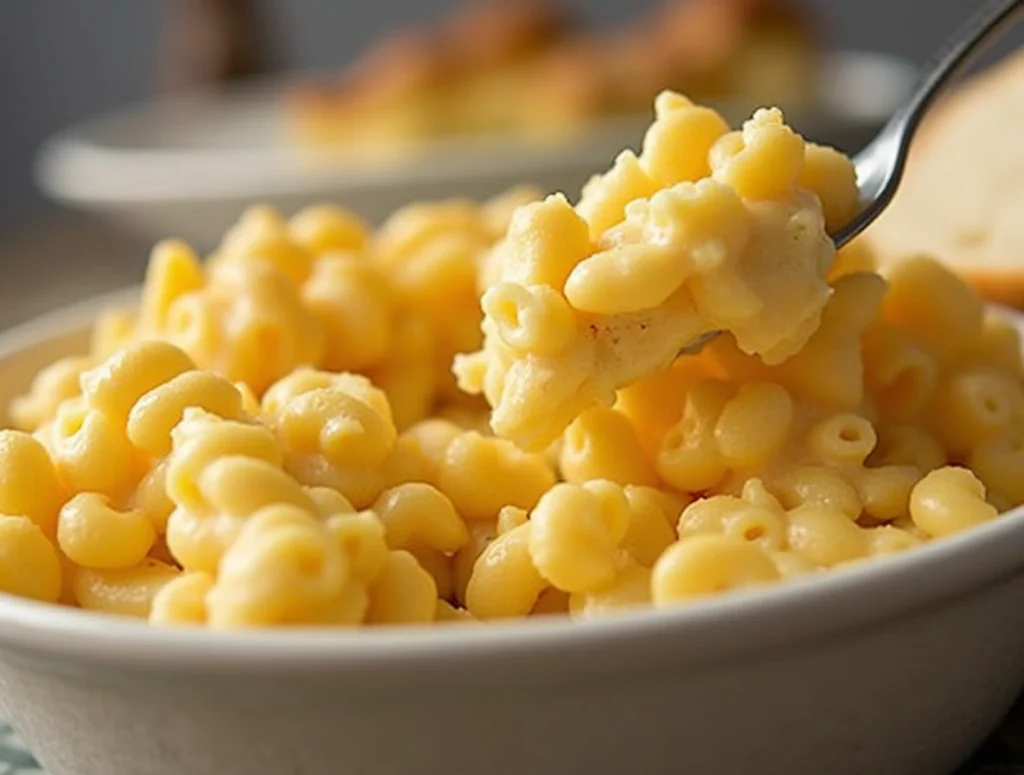
While pasta and cheese combinations have existed for centuries, American-style macaroni and cheese have developed a distinct identity that transcends its European roots. From blue box convenience to sophisticated restaurant versions with lobster or truffle, mac and cheese represents American comfort food.
From Presidential Origins to Pantry Staple
Thomas Jefferson is often credited with popularizing macaroni and cheese in America after encountering similar dishes during his time in France. He served a version at a state dinner in 1802, giving this humble dish presidential endorsement.
The dish became a widespread household staple during the Great Depression when Kraft introduced their boxed version in 1937, providing an affordable protein source during difficult economic times. This industrialization of mac and cheese made it accessible to millions of Americans.
Today, mac and cheese span the culinary spectrum from everyday family dinners to upscale restaurant fare, with countless creative interpretations.
Regional American Foods Mac and Cheese Styles
American mac and cheese has developed distinct regional variations:
- Southern-style baked mac and cheese is custard-like, often using eggs to create a firm texture that can be cut into squares
- Soul food versions frequently incorporate multiple cheeses and bake until a dark golden crust forms
- Vermont-style uses sharp cheddar and a touch of maple for sweetness
- Midwest preparations often include a breadcrumb topping and sometimes ground beef
The Science of Perfect Cheese Sauce
The key to transcendent mac and cheese lies in understanding the chemistry of cheese sauce. When heated, the proteins in cheese tend to separate, resulting in a grainy texture. The solution is to create a proper roux-based béchamel sauce first, which provides the perfect emulsification environment for the cheese.
Sodium citrate (often found in processed cheeses) helps maintain a smooth texture, so some chefs use a small amount of American cheese, even in gourmet versions.
Chef HAMZA’s Ultimate Five-Cheese Mac
This recipe combines old-world technique with American abundance:
Ingredients
1 pound elbow macaroni
4 tablespoons unsalted butter
4 tablespoons all-purpose flour
4 cups whole milk, warmed
2 cups sharp cheddar, grated
1 cup Gruyère, grated
1 cup fontina, grated
½ cup Parmesan, grated
2 slices American cheese (for emulsification)
1 teaspoon dry mustard powder
½ teaspoon garlic powder
¼ teaspoon cayenne pepper (optional)
Salt and freshly ground black pepper
For the topping: 1 cup panko breadcrumbs mixed with two tablespoons melted butter and two tablespoons Parmesan.
Method:
- Cook pasta for 2 minutes less than the package directions. Drain and set aside.
- Preheat oven to 375°F. Butter a 9×13 baking dish.
- In a large saucepan, melt butter over medium heat. Add flour and whisk constantly for 1-2 minutes until light golden.
- Gradually whisk in warm milk. Cook, stirring frequently, until the sauce thickens enough to coat the back of a spoon.
- Remove from heat and add cheeses in batches, stirring until completely melted. Add seasonings.
- Fold in cooked pasta, ensuring each piece is coated.
- Transfer to a baking dish and top with breadcrumb mixture.
- Bake for 25-30 minutes until bubbly and golden.
- Let rest for 10 minutes before serving.
The perfect mac and cheese should have a silky, creamy sauce that clings to each pasta piece, with a balanced cheese flavor that’s rich but not overwhelming.
4. Barbecue: The American Foods Low and Slow Flavor Religion
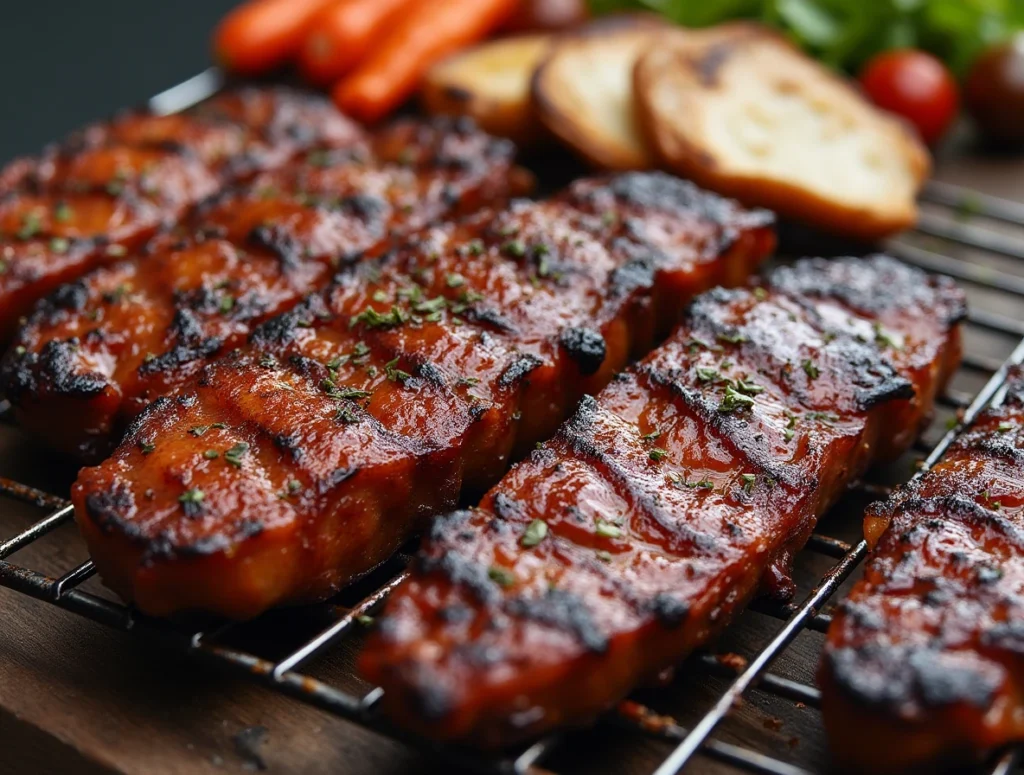
No American food inspires more passionate debate than barbecue. It’s not just a cooking method but a cultural institution with deep regional roots and fierce loyalty. True American barbecue refers specifically to the slow smoking of meat over indirect heat—not to be confused with grilling, which is direct-heat cooking.
The Four Great American Foods Barbecue Traditions
American barbecue can be divided into four main regional styles, each with distinctive characteristics:
- Carolina Barbecue: Focuses on whole hog (Eastern North Carolina) or pork shoulder (Western North Carolina) with vinegar-based sauces in the east and tomato-vinegar sauces in the west
- Texas Barbecue: Centered around beef, particularly brisket, with minimal rubs and sauces that don’t overpower the meat’s flavor
- Kansas City Barbecue: Embraces multiple types of meat with sweet, thick, tomato-molasses sauces and a focus on burnt ends
- Memphis Barbecue: Known for dry-rubbed ribs and pulled pork shoulder, often served without sauce or with a thinner, tangy sauce on the side
The Art and Science of Smoking
Great barbecue comes from understanding these fundamental principles:
- Wood Selection: Different woods impart different flavors—hickory is strong and traditional, oak is versatile, and fruit woods add sweetness
- Temperature Control: Maintaining a consistent low temperature (usually 225-275°F) throughout the long cooking process
- The Stall: Understanding that meat temperature will plateau (the “stall”) during cooking as moisture evaporates
- Bark Formation: Developing that prized dark exterior through the combination of rub, smoke, and the Maillard reaction
- Rest Time: Allowing meat to rest properly, sometimes for hours, in an insulated cooler for brisket
Chef HAMZA’s Texas-style brisket
After studying with pitmasters across Texas, here’s my approach to this barbecue classic:
Ingredients
12-14 pound whole beef brisket, untrimmed (look for good marbling)
¼ cup kosher salt
¼ cup coarse black pepper
2 tablespoons garlic powder (optional)
Oak or hickory wood chunks for smoking
Method:
- Trim excess fat, leaving about ¼-inch fat cap.
- Combine salt, pepper, and garlic powder if using. Apply liberally to the entire brisket.
- Let sit at room temperature for 1 hour.
- Prepare the smoker for indirect cooking at 250°F with a water pan for humidity.
- Place brisket fat side up, with the point (thicker end) toward the heat source.
- Maintain temperature, adding wood chunks as needed for consistent smoke.
- After 4 hours, spritz occasionally with water or beef broth in a spray bottle.
- When the internal temperature reaches 165°F (about 6-8 hours in), wrap tightly in butcher paper.
- Return to smoker until internal temperature reaches 203°F in the thickest part (about 4-6 more hours).
- Rest the wrapped brisket in a cooler lined with towels for at least 1 hour, preferably 2-3 hours.
- Slice against the grain, serving from the flat end.
The mark of perfect brisket is the “jiggle test”—when properly cooked, it should quiver like jelly when shaken gently. The meat should pull apart with minimal resistance but not fall apart, maintaining its moisture and showing a pronounced smoke ring.
5. Fried Chicken: The Crispy American Foods Classic
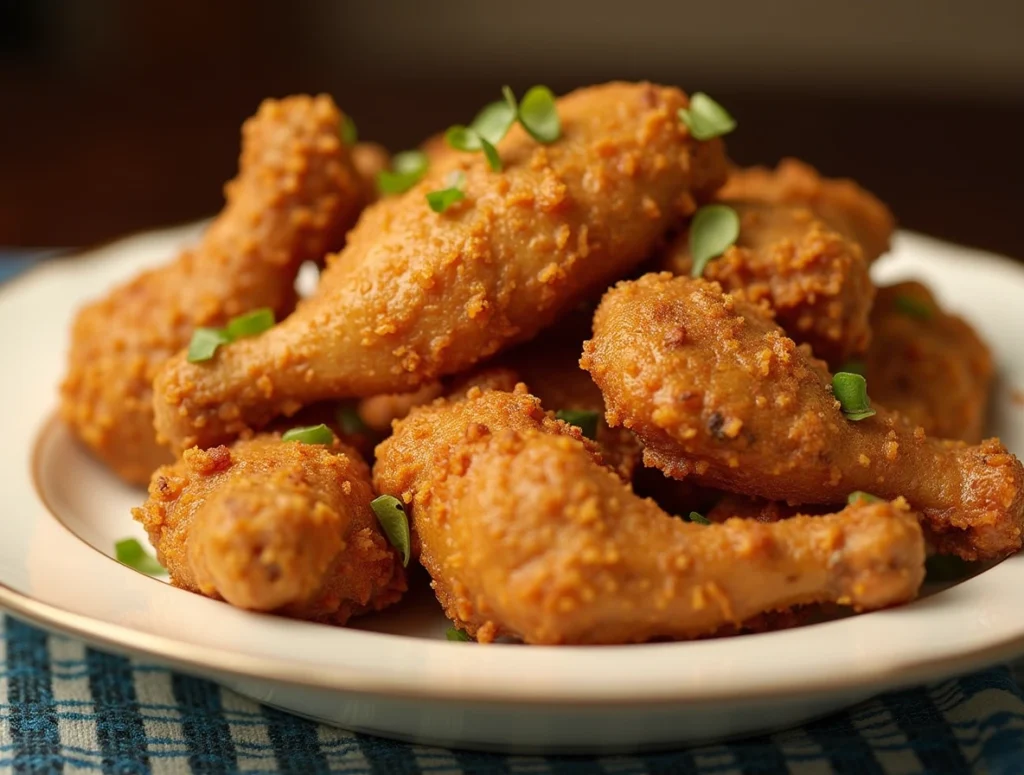
Fried chicken represents the beautiful cultural exchange at the heart of American cuisine. This dish evolved through the cooking techniques of Scottish immigrants and enslaved West Africans, developing into one of America’s most beloved foods that transcends regional and racial boundaries.
The Cultural Origins of top 10 American foods Fried Chicken
Scottish immigrants brought their tradition of frying chicken to America but typically prepared it without seasoning. West African cooks, many of whom were enslaved, transformed this basic technique with spices and herbs from their culinary heritage. This fusion created the foundation for Southern fried chicken.
After the Civil War, fried chicken became associated with Sunday dinners and special occasions due to the labor involved and the relative scarcity of chickens. As chicken farming industrialized in the 20th century, fried chicken became more accessible, eventually leading to fast-food empires like KFC.
Regional Variations That Define the Dish American Foods
American fried chicken has developed distinctive regional approaches:
- Nashville Hot Chicken: Characterized by its fiery cayenne paste applied after frying
- Maryland Fried Chicken: Often served with a cream gravy and accompanied by cornbread
- Louisiana-style: Incorporates Cajun and Creole seasonings into the coating
- Korean-American Fried Chicken: A more recent fusion featuring double-frying techniques and sweet-spicy glazes
The Science of Crunch: What Makes Perfect American Foods Fried Chicken
Creating transcendent fried chicken requires understanding these key principles:
- Brining: Soaking chicken in seasoned saltwater ensures moisture and flavor penetration
- Double dredging: Creating multiple layers of flour coating develops extra crunch
- Proper oil temperature: Starting at 350°F and maintaining between 325-350°F throughout cooking
- Resting on a rack: Allowing excess oil to drain prevents sogginess
Chef HAMZA’s Southern Buttermilk Fried Chicken
This recipe represents my ideal version after testing countless variations:
Ingredients
1 whole chicken (3-4 pounds), cut into eight pieces
2 cups buttermilk
2 tablespoons hot sauce
2 tablespoons kosher salt, divided
3 cups all-purpose flour
1 tablespoon black pepper
2 teaspoons garlic powder
2 teaspoons onion powder
1 teaspoon paprika
1 teaspoon cayenne pepper
½ teaspoon dried thyme
½ teaspoon dried oregano
Vegetable oil or peanut oil for frying
Method:
- Combine buttermilk, hot sauce, and one tablespoon of salt in a large bowl. Add chicken pieces, cover, and refrigerate for at least 4 hours, preferably overnight.
- Combine flour with remaining salt and all seasonings in a large paper bag or bowl.
- Remove chicken from buttermilk, allowing excess to drip off.
- Dredge each piece in the flour mixture, back into the buttermilk, and again in the flour (double dredging).
- Place on a wire rack and rest for 15-20 minutes while heating oil.
- Fill a large, heavy pot or deep skillet with 2 inches of oil. Heat to 350°F.
- Fry chicken in batches, beginning with dark meat. Maintain temperature between 325-350°F.
- Cook until golden brown and internal temperature reaches 165°F (about 12-15 minutes for dark meat, 8-10 for white meat).
- Drain on a wire rack, not paper towels, to maintain crispiness.
- Let rest for 10 minutes before serving.
Perfect fried chicken should have a shatteringly crisp exterior that audibly crunches when bitten, revealing juicy, flavorful meat inside. The seasoning should be present but balanced, enhancing rather than overwhelming the chicken flavor.
6. Hot Dogs: The American Foods Ballpark Favorite to Gourmet Canvas
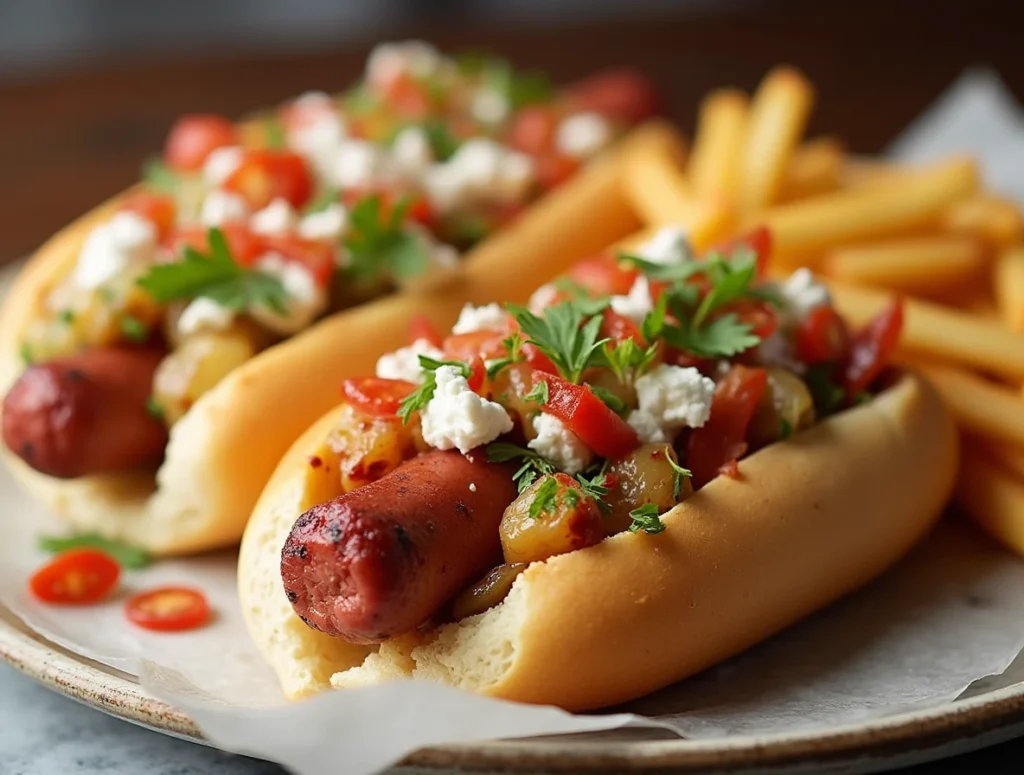
The hot dog—derived from European sausage traditions but transformed into something distinctly American—has become an edible icon of American casual dining, sporting events, and summer cookouts. From street carts to high-end restaurants reinterpreting this classic, the hot dog represents American food culture’s democratic spirit.
From Immigrant Top 10 American Foods Icon
German immigrants brought their frankfurters and wieners to America in the 19th century. These sausages transformed into the modern American hot dog through several evolutionary steps, including adding the Bun (attributed to various origin stories, including the 1904 St. Louis World’s Fair).
The hot dog gained national prominence when President Franklin D. Roosevelt served them to King George VI during his 1939 visit, declaring them uniquely American fare fit even for royalty. This presidential endorsement cemented the hot dog’s status in American culture.
Regional Hot Dog Styles That Define American Foods Cities
Few foods showcase regional American pride, like the hot dog, with cities developing signature styles:
- Chicago-style: An all-beef hot dog on a poppy seed bun topped with yellow mustard, green relish, chopped onions, tomato slices, pickle spear, sport peppers, and a dash of celery salt—never ketchup
- New York-style: Topped simply with sauerkraut and spicy brown mustard, often from pushcarts
- Detroit Coney: Topped with a meat-based chili sauce, yellow mustard, and diced onions
- Arizona Sonoran: Bacon-wrapped and topped with pinto beans, grilled onions, tomatoes, mayonnaise, mustard, and jalapeños
- Seattle-style: With cream cheese and grilled onions
The Anatomy of the Perfect Hot Dog
Creating an exceptional hot dog experience requires attention to these elements:
- The Sausage: Ideally, it should be all-beef with natural casing for the signature “snap.”
- The Bun Should be steamed or lightly toasted to provide structure without toughness.
- The Toppings Should complement rather than overwhelm the flavor of the hot dog itself
- The Balance: Achieving the perfect ratio of hot dog to bun to toppings
Chef HAMZA’s Gourmet Hot Dog Bar
When I host summer gatherings, I create a hot dog bar with homemade toppings that elevate this humble food:
Base Elements:
- All-beef hot dogs with natural casings
- Top-split New England-style buns, butter-grilled
- Yellow mustard, spicy brown mustard, and Dijon mustard
Gourmet Topping Stations:
Classic American:
- Homemade beef chili
- Finely diced white onions
- Sharp cheddar cheese sauce
Sophisticated German:
- House-fermented sauerkraut with caraway
- Caramelized onions with beer
- Whole grain mustard
New American Fusion:
- Kimchi relish
- Sriracha mayo
- Crispy fried shallots
Sweet & Savory:
- Apple-jalapeño slaw
- Bacon jam
- Frizzled leeks
Cooking Method:
- Simmer hot dogs in beer with onions until heated through.
- Transfer to a medium-high grill to develop char marks and caramelization.
- Meanwhile, brush the buns with butter and grill until golden.
- Allow guests to build their combinations from the topping stations.
A genuinely great hot dog should have a juicy interior with a satisfying snap when bitten, complemented by toppings that create a harmony of flavors and textures.
7. Thanksgiving Turkey: The Ceremonial Centerpiece
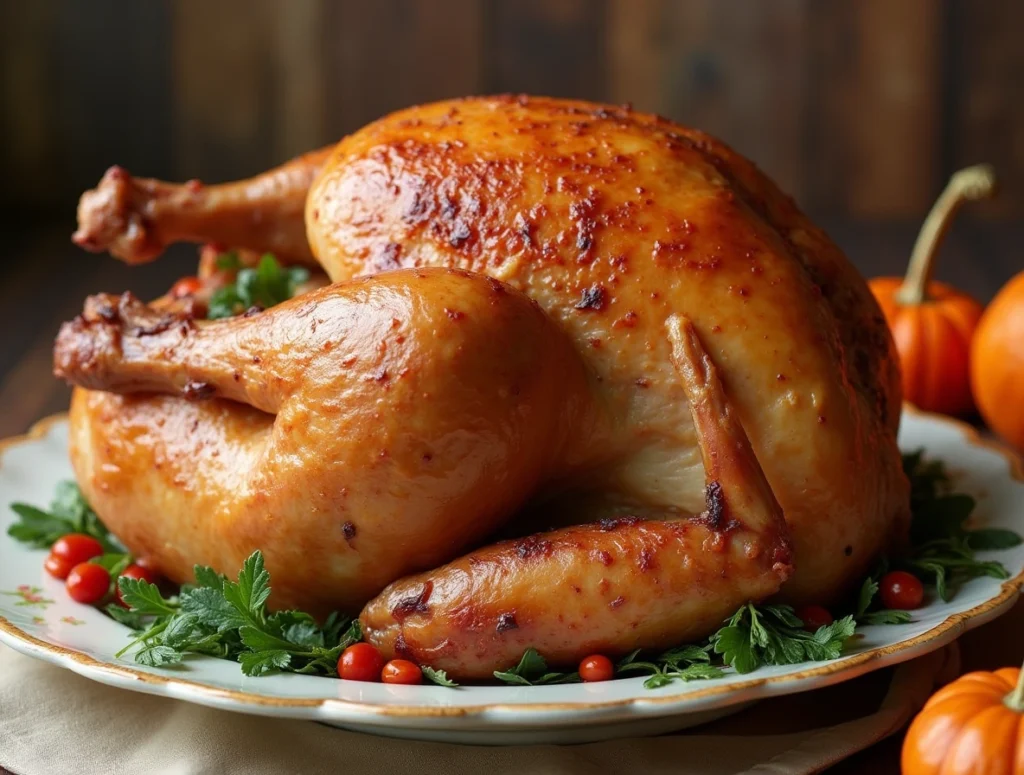
While not an everyday food, the Thanksgiving turkey represents American culinary tradition in its purest form—a meal that brings together families across the country daily to participate in a shared national food ritual. No other American dish carries such ceremonial significance.
From Pilgrim Origins to National Tradition
While historical records don’t confirm turkey at the first Thanksgiving in 1621, by the late 1800s, it had become the traditional centerpiece of the meal. President Abraham Lincoln’s proclamation of Thanksgiving as a national holiday in 1863 helped standardize the celebration, with turkey gradually becoming the expected main course.
The Norman Rockwell painting “Freedom from Want,” depicting a family turkey dinner, cemented this image in the American consciousness during World War II. Today, approximately 46 million turkeys are consumed each Thanksgiving, making it America’s most coordinated food event.
The Evolution of Turkey’s Preparation
American turkey cooking methods have evolved considerably:
- Traditional roasting gave way to innovations like deep-frying in the South
- Bringing became popular in the 1990s to combat dryness
- Spatchcocking (butterflying) gained popularity for faster, more even cooking
- Heritage breeds have seen a revival as alternatives to commercial broad-breasted whites
The Science of Moist Turkey
The challenge with turkey has always been cooking the dark meat to a food-safe temperature without drying out the breast meat. Modern approaches address this through:
- Differential Temperature: Targeting different final temperatures for breast (155°F) and thigh meat (175°F)
- Brining or Dry Brining: Using salt to help muscle fibers retain moisture
- Butter Under the Skin: Creating a protective layer of fat
- Proper Resting: Allowing juices to redistribute through the meat
Chef HAMZA’s Herb-Butter Roasted Turkey
After preparing hundreds of turkeys over my career, here’s my most reliable method:
Ingredients
14-16 pound turkey, preferably fresh
For dry brine: ½ cup kosher salt, two tablespoons baking powder, two tablespoons brown sugar
1 cup (2 sticks) unsalted butter, softened
4 cloves garlic, minced
2 tablespoons fresh thyme leaves
2 tablespoons fresh rosemary, finely chopped
2 tablespoons fresh sage, finely chopped
Zest of 1 lemon
1 tablespoon black pepper
1 orange, quartered
1 lemon, quartered
1 onion, quartered
1 bunch fresh herbs (thyme, rosemary, sage)
2 cups chicken stock
Method:
- Three days before cooking, remove the giblets and neck from the turkey. Pat dry thoroughly.
- Mix the dry brine ingredients and rub all over the turkey, inside and out. Place on a rack over a baking sheet and refrigerate uncovered for 24-48 hours.
- Combine softened butter with garlic, herbs, lemon zest, and pepper the day before cooking.
- Gently loosen the skin over the breasts and thighs. Spread two-thirds of the herb butter under the skin.
- Refrigerate turkey uncovered overnight to dry skin further.
- Remove turkey from refrigerator 1-2 hours before roasting.
- Preheat oven to 425°F.
- Stuff the cavity with citrus quarters, onion, and herb bunch.
- Rub the remaining herb butter over the skin. Tie legs together and tuck wing tips.
- Pour the stock into a roasting pan and place the turkey on a rack.
- Roast at 425°F for 30 minutes, then reduce temperature to 325°F.
- Baste every 30 minutes after the first hour.
- Tent breast with foil if browning too quickly.
- Cook until breast registers 155°F and thighs reach 170-175°F (about 13-15 minutes per pound).
- Rest turkey, tented with foil, for at least 30 minutes before carving.
The perfect turkey should have crisp, golden skin, with breast meat that’s juicy and tender and dark meat that’s rich and fully cooked. The flavor should be enhanced but not overwhelmed by the herbs and butter.
8. Clam Chowder: American Foods Coastal Comfort
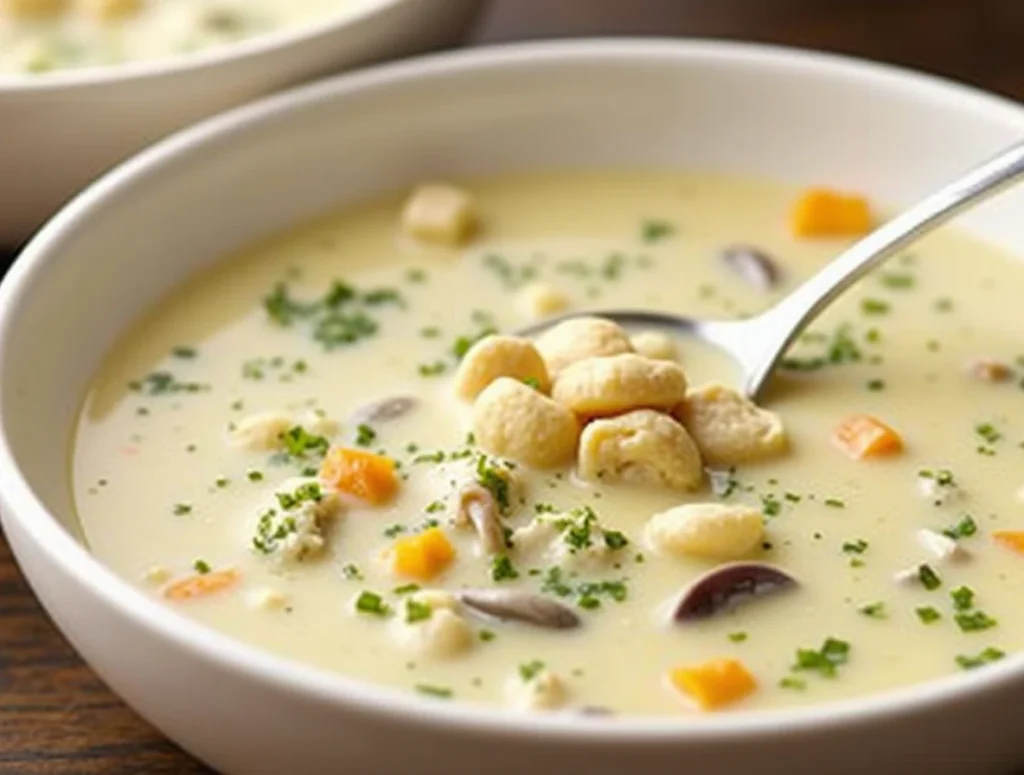
Few dishes better represent American regional cooking pride than clam chowder. This hearty soup has developed distinct variations along the Eastern Seaboard, with passionate defenders of each style. Despite these regional divisions, clam chowder, in all its forms, represents America’s connection to its coastal bounty.
The Great Chowder Debate: New England vs. Manhattan
The two most prominent chowder styles represent a fundamental culinary divide:
- New England Clam Chowder: A creamy, milk or cream-based soup with potatoes, onions, and clams. Laws were proposed (though never passed) in Maine in 1939, making it illegal to add tomatoes to chowder.
- Manhattan Clam Chowder: This dish features a clear, tomato-based broth without dairy. It emerged in the mid-1800s under the influence of Portuguese and Italian immigrants working in New York’s fishing industry.
Additional regional variations include:
- Rhode Island Clear Chowder: With a clear broth base
- Long Island Chowder: Combining cream and tomato
- Hatteras Chowder: From North Carolina’s Outer Banks, using clear broth with bacon
The Elements of Exceptional Chowder
Creating transcendent chowder requires attention to these details:
- The Clams: Quahogs (hard-shell clams) are traditional, with their juice providing an essential briny flavor
- The Texture: Properly diced potatoes should maintain their integrity without disintegrating
- The Balance: Achieving the perfect ratio of clams to potatoes to broth
- The Finish: A hint of herbs without overwhelming the delicate clam flavor
Chef HAMZA’s New England Clam Chowder
This recipe represents my ideal version after cooking on both coasts:
Ingredients
4 slices thick-cut bacon, diced
1 large onion, finely diced
2 stalks celery, finely diced
3 tablespoons all-purpose flou
2 cups clam juice (bottled or from steamed clams)
2 cups chicken stock
1½ pounds Yukon Gold potatoes, diced into ½-inch cubes
1 bay leaf
½ teaspoon dried thyme
2 pounds fresh quahog or cherrystone clams, steamed an
